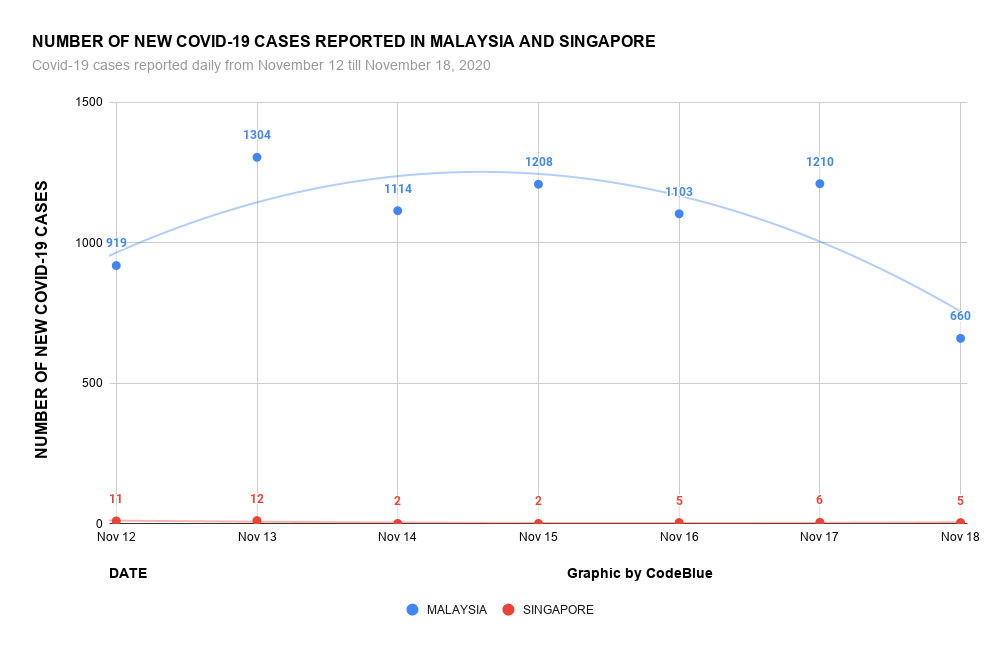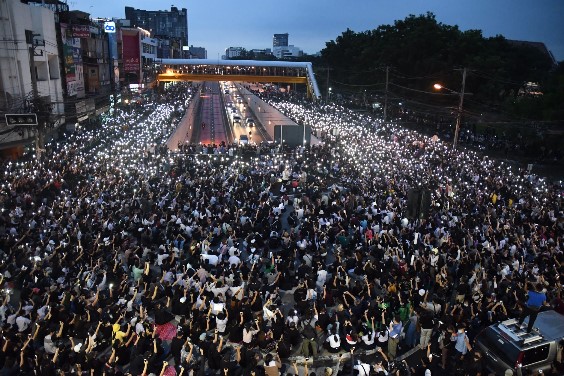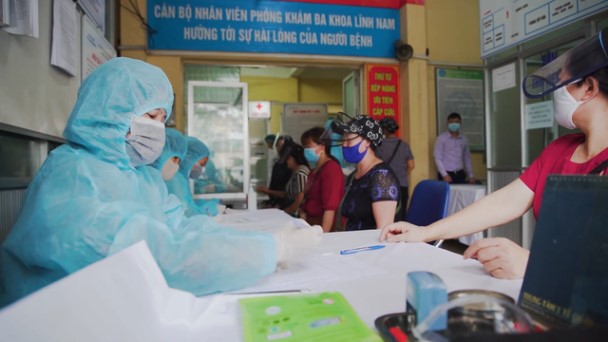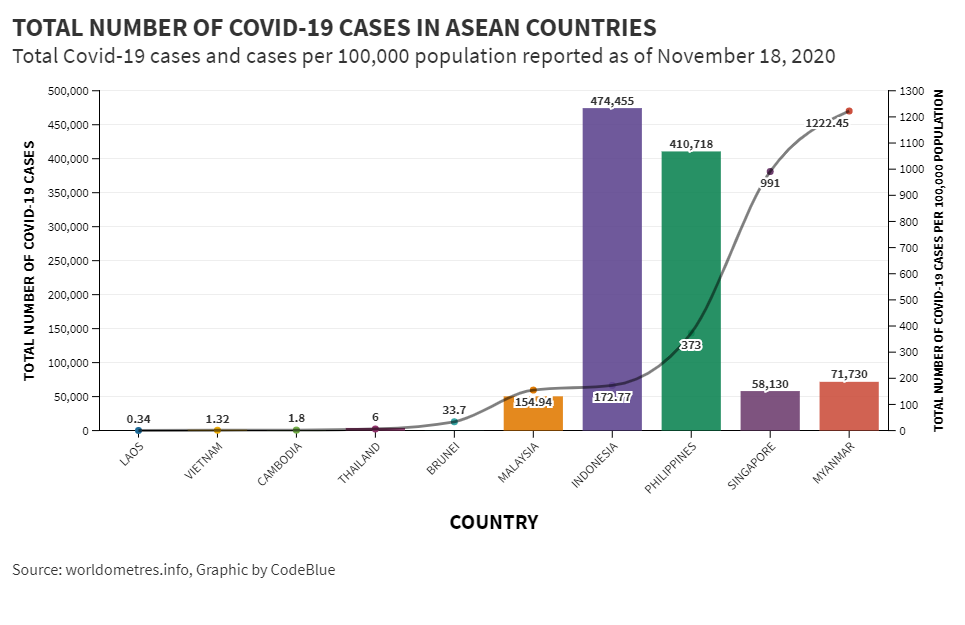KUALA LUMPUR, Nov 18 — Malaysia has recorded a total of 50,390 Covid-19 cases as of today, surging past the 50,000-mark about 10 months after the first infections officially entered the country on January 25.
Today, Malaysia reported four new deaths from Covid-19 and 660 new coronavirus cases, breaking the past five-day trend of consecutive daily infections above 1,000.
If Malaysia’s trend of above 1,000 daily cases persists tomorrow onwards, however, according to the Ministry of Health’s (MOH) projection with a nationwide R0 value of between 0.9 and 1.1, Malaysia’s total number of Covid-19 cases might just surpass, in a week or so, the cumulative figure reported in Singapore at 58,130 cases as of today. The neighbouring country has been reporting zero new local transmissions over the past eight days.
Malaysia, with 50,390 total Covid-19 cases as of today, is in fifth position in ASEAN after Indonesia (474,455 cases), the Philippines (410,718), Myanmar (71,730), and Singapore (58,130), in terms of the total number of Covid-19 cases.
The other five countries in the region have reported cumulative Covid-19 cases below 5,000 as of today: Thailand (3,878 cases), Vietnam (1,288), Cambodia (303), Brunei (148), and Laos (25).
In terms of the total number of Covid-19 cases per 100,000 population, Myanmar had the highest in ASEAN at 1,222.45, followed by Singapore (991), the Philippines (373), Indonesia (172.77), and Malaysia in fifth place at 154.94 per 100,000 population. Brunei reported only 33.7 total Covid-19 cases per 100,000 population, followed by Thailand, and Vietnam with just six and 1.32 coronavirus cases per 100,000 population respectively.
As for the total number of Covid-19 deaths, Malaysia is the fourth highest among ASEAN countries, reporting a total of 322 deaths as of today. Indonesia racked up the highest total number of coronavirus fatalities in the region at 15,393, followed by the Philippines (7,862), and Myanmar (1,625). The other six countries in the region reported below 100 coronavirus deaths.
Malaysia’s total 322 Covid-19 deaths is 11 times higher than Singapore’s total number of deaths, which is only 28. Moreover, Thailand and Vietnam have only two-digit casualties from Covid-19, at 60 and 35 respectively. Brunei recorded just three Covid-19 deaths. Countries like Laos, which had 25 positive Covid-19 cases, and Cambodia with 303 cases have not reported any deaths from coronavirus.
In terms of the total number of Covid-19 deaths per 100,000 population, Myanmar marked the highest in the region at 27.69 deaths per 100,000 population, followed by the Philippines (7.14), Indonesia (5.6), and Malaysia in fourth place at 0.99 deaths per 100,000 population.
Singapore Has Been Reporting Single-Digit Cases With Zero Local Infections

Over the past one week, Singapore’s daily Covid-19 tally has been fewer than 10 cases on most days and all their cases were imported, with zero locally transmitted cases. The graph above shows a simple comparison between the total number of cases reported in Malaysia and Singapore in the past one week.
The average number of Covid-19 cases reported in Malaysia over the past week was 1,074 from November 12 till November 18, almost 175 times more than Singapore at 6.15.
Testing is one of Singapore’s key strategies in containing the spread of the coronavirus. Singapore has swabbed a total of 1.16 million people as of yesterday. The government had tested all their migrant workers, as a major proportion of Singapore’s Covid-19 cases (49,375) were detected in migrant workers who live in cramped dormitories, where social distancing is not possible. By August 7, the government had completed their testing of migrant workers living in dormitories.
At the beginning of the Covid-19 pandemic, the Singapore government announced that all medical expenses related to testing and treatment would be covered and S$100 (RM305.07) per day would be given to those quarantined to compensate for any loss of income.
This means, during the 14 day period of quarantine, each individual is given up to S$1400 (RM4,272.22). In Malaysia, no compensation is given to those who are quarantined, while only food baskets are distributed to residents who live under the enhanced movement control order (EMCO) area.
The Singaporean government also created a WhatsApp account ‘Gov.sg’, subscribed to by hundreds of thousands of Singaporean residents, that issues two to three daily reminders about public health measures, including the daily Covid-19 tally. In closed Telegram chat groups, Singapore’s MOH works with physicians to obtain feedback and explains, in more technical and candid terms, the rationale behind certain policies.
The government announced a “circuit breaker”,a nationwide lockdown after a rise in locally transmitted and unlinked cases. The lockdown was implemented from April 7 till June 1 which was almost three months.
Singapore’s efforts in returning to normalcy have been implemented in phases. On June 2, Singapore entered Phase One of reopening, whereby businesses and activities were progressively allowed. Parents and grandparents can only visit up to two visitors at once from the same households. Meanwhile, schools were allowed to reopen but only some students were allowed to attend daily lessons.
Phase Two was started on June 19, whereby dine-ins were permitted and households could receive up to five visitors. The number of people allowed at marriage solemnisation were expanded to 50 people, while up to 30 people could be present at funerals and wakes.
Singapore’s government said that the country may enter Phase Three before the year ends. Singapore’s Minister of Health Gan Kim Yong said that Phase Three could last for a prolonged period, even more than a year. For Phase Three, larger gatherings will be allowed at home, from five at present to eight. For weddings and receptions, there is a plan to separate the events area into multiple zones, each accommodating 50 people. High-risk settings like bars, pubs, karaoke lounges, and nightclubs will be allowed to resume at the start of Phase Three.
Moreover, Singapore has co-developed a Covid-19 vaccine along with an American pharmaceutical company, Arcturus Therapeutics, which had announced positive preliminary results from their early clinical trials.
The first shipments for this vaccine is expected to arrive early next year. Singapore has formed a committee to prioritise people who should be given the vaccine once it becomes available.
Malaysia Maintains Same Screening Strategy, Uses Lockdowns

Malaysia’s public health approach in handling Covid-19 appears to have been largely the same, through the previous and now the current third wave, since the epidemic landed in Malaysia last January.
In terms of screening, MOH does pre-operative testing in hospitals, besides screening close contacts of confirmed cases, high-risk groups like severe acute respiratory illness (SARI) patients, and those returning from overseas and Sabah (after the Sabah state election on September 26). It is unclear if Malaysia has been conducting mass testing in certain regions, such as in Sabah at the height of its Covid-19 crisis last month, due to the lack of official published information.
Singapore, on the other hand, reports the average daily number of swabs tested over the past week and individuals tested to date. On Singapore’s MOH website, the information is freely available for the public, but Malaysia’s MOH doesn’t publish reports on daily testing statistics as well as the number of individuals swabbed.
Health director-general Dr Noor Hisham Abdullah verbally told a press conference earlier today that 28,301 RT-PCR tests were conducted nationwide yesterday, or 48 per cent of testing capacity. Singapore, whose population is almost six times smaller than Malaysia, has tested about 23,000 swabs a day over the past week, as of November 16.
So far, there have been no reports on the number of tests done among migrant workers in Malaysia. Moreover, migrant workers in Malaysia don’t necessarily live in designated dormitories, unlike Singapore, but also live in rental homes. There are also undocumented migrants among these workers in Malaysia.
In terms of lockdowns, Malaysia has implemented various forms of movement restrictions — movement control order (MCO), conditional movement control order (CMCO), enhanced movement control order (EMCO), recovery movement control order (RMCO), and targeted enhanced movement control order (TEMCO).
Malaysia started with a seven-week strict nationwide MCO on March 18, followed by CMCO and then RMCO. When Covid-19 cases start to rise, through MOH’s risk assessment, either a CMCO (on an entire region or state) or an EMCO will be implemented. EMCOs, which do not permit residents from leaving their home, are usually targeted on specific residences, with mass testing done on the community.
However, the standard operating procedures (SOPs) for each form of lockdown changes often and is not fixed for a certain period of time. For example, when a CMCO was implemented in Klang Valley, the government announced that dine-ins were not allowed; a day later, they announced it was allowed.
On October 14, the whole of Klang Valley was kept under CMCO. A month later, the CMCO was extended for a month to the entire peninsular Malaysia, except Kelantan, Perlis, and Pahang. Despite getting slammed by MPs across the aisle as well as health experts on the CMCO, the government strongly believes that this method is suitable in containing the virus.
Thailand: A Good Example Of A Comprehensive Approach

Thailand, with a total population of 69.86 million that is double Malaysia’s 32.51-million population, has almost 13 times lower the number of Covid-19 cases as compared to Malaysia. This means, despite having a higher population as compared to Malaysia, Thailand has a lower total number of Covid-19 cases.
Over the past one week, Thailand’s daily Covid-19 cases have been less than 10: on November 18 (two cases), November 17 (three cases), November 16 (one case), November 15 (eight cases), November 14 (five cases), November 13 (nine cases) ,and November 12 (five cases).
Amid the coronavirus pandemic, Thais have been carrying out protests against the country’s proposed constitutional changes. Videos of protests also showed protestors wearing a face mask while rallying.
World Health Organization (WHO) head Tedros Adhanom Ghebreyesus has praised Thailand, saying that it is an excellent example of a whole-of-government, whole-of-society, and comprehensive approach to contain the virus.
One of Thailand’s measures in containing the coronavirus include rallying multi-tasking village health volunteers. Around the whole country, about 1.04 million health volunteers are working in 75,032 villages near and far. Most of these volunteers are women who know their communities very well.
They visit households, updating them on the pandemic besides checking on their health, especially the elderly. They work closely with all health officials and keep an eye on all those coming and leaving the communities.
Ordinary citizens are cooperative in ensuring their personal safety as a study showed 95 per cent of Thais are wearing face masks in public during the pandemic which is the highest rate in Southeast Asia. The public is strict about mask-wearing.
A writer from National Geographic described it by saying “If I forgot to wear one, the ‘aunties’ on the streets glare at me intensely, making me run back home in shame to grab a mask.”
Thailand declared a state of emergency from March 26 till July 31, but eased lockdown regulations since May 3. Restaurants, hair salons, and parks were allowed to operate from May 3. During the pandemic, Thailand’s tourism had faced a huge loss due to the closure of borders. Now, the government has started to allow tourists to visit the country, including medical tourists, to slowly boost tourism.
Vietnam Developed Diagnostic Test Kits And Tested More People

In late January, Vietnam’s government had encouraged their country’s virologists to develop diagnostic tests. By February, publicly funded institutions had developed at least four locally made Covid-19 tests that were approved by the National Institute of Hygiene and Epidemiology, which were then manufactured by private companies.
By May, Vietnam managed to ramp up testing capacity. The country used the strategy to identify clusters to prevent wider transmission when it was reporting a low number of Covid-19 cases. However, when community transmission was detected in even one case, the government quickly expanded local testing to ensure no cases were missed.
Vietnam’s contact tracing method is also different from Malaysia. Not only are close contacts of a positive case tested and isolated, but close contacts of the first close contacts are also quarantined for 14 days. Moreover, Vietnam implemented immediate targeted lockdowns on suspected hotspots and also a nationwide lockdown, which was extended to 21 days from April 1.
Vietnam, with a population of 97.67 million that is three times larger than Malaysia, has only 1,288 positive Covid-19 cases as of November 17, with a total number of deaths of 35. Over the past one week, the average number of Covid-19 cases reported was only 9.71. Vietnam also shares a border with China, where Covid-19 was first reported in the central city of Wuhan last December.
“One of the reasons Vietnam was able to act so quickly is that the country experienced SARS in 2003 and human cases of avian influenza between 2004 and 2010. Therefore, Vietnam had both the experience and infrastructure to take appropriate action,” writers comprising various Vietnamese health experts, as well as experts from Oxford University and the World Bank in Vietnam, wrote in a June 30 article for the Exemplars in Global Health platform.
Hanoi, Vietnam’s capital city, has allowed bars, clubs, and karaoke joints to reopen from September 16 after going 28 days without community transmission of the virus. Ho Chi Minh City authorities have allowed the reopening of bars and clubs from September 7 after no local transmissions were reported for more than a month.








